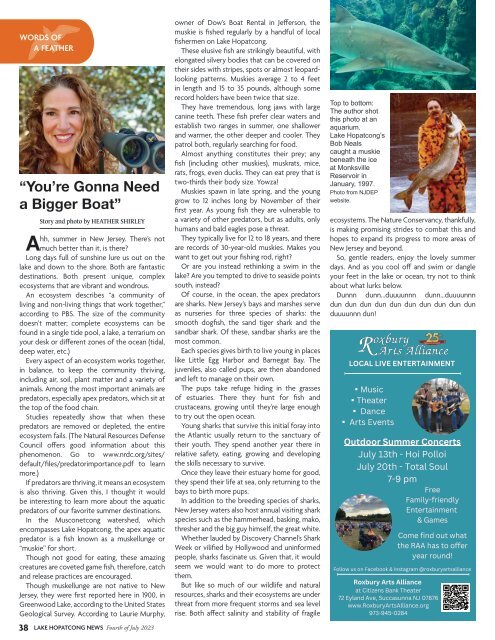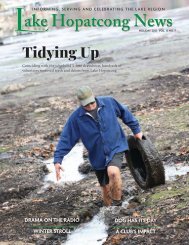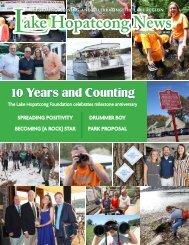You also want an ePaper? Increase the reach of your titles
YUMPU automatically turns print PDFs into web optimized ePapers that Google loves.
WORDS OF<br />
A FEATHER<br />
“You’re Gonna Need<br />
a Bigger Boat”<br />
Story and photo by HEATHER SHIRLEY<br />
Ahh, summer in New Jersey. There’s not<br />
much better than it, is there?<br />
Long days full <strong>of</strong> sunshine lure us out on the<br />
lake and down to the shore. Both are fantastic<br />
destinations. Both present unique, complex<br />
ecosystems that are vibrant and wondrous.<br />
An ecosystem describes “a community <strong>of</strong><br />
living and non-living things that work together,”<br />
according to PBS. The size <strong>of</strong> the community<br />
doesn’t matter; complete ecosystems can be<br />
found in a single tide pool, a lake, a terrarium on<br />
your desk or different zones <strong>of</strong> the ocean (tidal,<br />
deep water, etc.)<br />
Every aspect <strong>of</strong> an ecosystem works together,<br />
in balance, to keep the community thriving,<br />
including air, soil, plant matter and a variety <strong>of</strong><br />
animals. Among the most important animals are<br />
predators, especially apex predators, which sit at<br />
the top <strong>of</strong> the food chain.<br />
Studies repeatedly show that when these<br />
predators are removed or depleted, the entire<br />
ecosystem fails. (The Natural Resources Defense<br />
Council <strong>of</strong>fers good information about this<br />
phenomenon. Go to www.nrdc.org/sites/<br />
default/files/predatorimportance.pdf to learn<br />
more.)<br />
If predators are thriving, it means an ecosystem<br />
is also thriving. Given this, I thought it would<br />
be interesting to learn more about the aquatic<br />
predators <strong>of</strong> our favorite summer destinations.<br />
In the Musconetcong watershed, which<br />
encompasses Lake Hopatcong, the apex aquatic<br />
predator is a fish known as a muskellunge or<br />
“muskie” for short.<br />
Though not good for eating, these amazing<br />
creatures are coveted game fish, therefore, catch<br />
and release practices are encouraged.<br />
Though muskellunge are not native to New<br />
Jersey, they were first reported here in 1900, in<br />
Greenwood Lake, according to the United States<br />
Geological Survey. According to Laurie Murphy,<br />
38<br />
LAKE HOPATCONG NEWS <strong>Fourth</strong> <strong>of</strong> <strong>July</strong> <strong>2023</strong><br />
owner <strong>of</strong> Dow’s Boat Rental in Jefferson, the<br />
muskie is fished regularly by a handful <strong>of</strong> local<br />
fishermen on Lake Hopatcong.<br />
These elusive fish are strikingly beautiful, with<br />
elongated silvery bodies that can be covered on<br />
their sides with stripes, spots or almost leopardlooking<br />
patterns. Muskies average 2 to 4 feet<br />
in length and 15 to 35 pounds, although some<br />
record holders have been twice that size.<br />
They have tremendous, long jaws with large<br />
canine teeth. These fish prefer clear waters and<br />
establish two ranges in summer, one shallower<br />
and warmer, the other deeper and cooler. They<br />
patrol both, regularly searching for food.<br />
Almost anything constitutes their prey; any<br />
fish (including other muskies), muskrats, mice,<br />
rats, frogs, even ducks. They can eat prey that is<br />
two-thirds their body size. Yowza!<br />
Muskies spawn in late spring, and the young<br />
grow to 12 inches long by November <strong>of</strong> their<br />
first year. As young fish they are vulnerable to<br />
a variety <strong>of</strong> other predators, but as adults, only<br />
humans and bald eagles pose a threat.<br />
They typically live for 12 to 18 years, and there<br />
are records <strong>of</strong> 30-year-old muskies. Makes you<br />
want to get out your fishing rod, right?<br />
Or are you instead rethinking a swim in the<br />
lake? Are you tempted to drive to seaside points<br />
south, instead?<br />
Of course, in the ocean, the apex predators<br />
are sharks. New Jersey’s bays and marshes serve<br />
as nurseries for three species <strong>of</strong> sharks: the<br />
smooth dogfish, the sand tiger shark and the<br />
sandbar shark. Of these, sandbar sharks are the<br />
most common.<br />
Each species gives birth to live young in places<br />
like Little Egg Harbor and Barnegat Bay. The<br />
juveniles, also called pups, are then abandoned<br />
and left to manage on their own.<br />
The pups take refuge hiding in the grasses<br />
<strong>of</strong> estuaries. There they hunt for fish and<br />
crustaceans, growing until they’re large enough<br />
to try out the open ocean.<br />
Young sharks that survive this initial foray into<br />
the Atlantic usually return to the sanctuary <strong>of</strong><br />
their youth. They spend another year there in<br />
relative safety, eating, growing and developing<br />
the skills necessary to survive.<br />
Once they leave their estuary home for good,<br />
they spend their life at sea, only returning to the<br />
bays to birth more pups.<br />
In addition to the breeding species <strong>of</strong> sharks,<br />
New Jersey waters also host annual visiting shark<br />
species such as the hammerhead, basking, mako,<br />
thresher and the big guy himself, the great white.<br />
Whether lauded by Discovery Channel’s Shark<br />
Week or vilified by Hollywood and uninformed<br />
people, sharks fascinate us. Given that, it would<br />
seem we would want to do more to protect<br />
them.<br />
But like so much <strong>of</strong> our wildlife and natural<br />
resources, sharks and their ecosystems are under<br />
threat from more frequent storms and sea level<br />
rise. Both affect salinity and stability <strong>of</strong> fragile<br />
Top to bottom:<br />
The author shot<br />
this photo at an<br />
aquarium.<br />
Lake Hopatcong’s<br />
Bob Neals<br />
caught a muskie<br />
beneath the ice<br />
at Monksville<br />
Reservoir in<br />
January, 1997.<br />
Photo from NJDEP<br />
website.<br />
ecosystems. The Nature Conservancy, thankfully,<br />
is making promising strides to combat this and<br />
hopes to expand its progress to more areas <strong>of</strong><br />
New Jersey and beyond.<br />
So, gentle readers, enjoy the lovely summer<br />
days. And as you cool <strong>of</strong>f and swim or dangle<br />
your feet in the lake or ocean, try not to think<br />
about what lurks below.<br />
Dunnn dunn…duuuunnn dunn…duuuunnn<br />
dun dun dun dun dun dun dun dun dun dun<br />
duuuunnn dun!<br />
LOCAL LIVE ENTERTAINMENT<br />
▪Music<br />
▪Theater<br />
▪ Dance<br />
▪ Arts Events<br />
Outdoor Summer Concerts<br />
<strong>July</strong> 13th - Hoi Polloi<br />
<strong>July</strong> 20th - Total Soul<br />
7-9 pm<br />
Free<br />
Family-friendly<br />
Entertainment<br />
& Games<br />
Come find out what<br />
the RAA has to <strong>of</strong>fer<br />
year round!<br />
Follow us on Facebook & Instagram @roxburyartsalliance<br />
Roxbury Arts Alliance<br />
at Citizens Bank Theater<br />
72 Eyland Ave, Succasunna NJ 07876<br />
www.RoxburyArtsAlliance.org<br />
973-945-0284
















